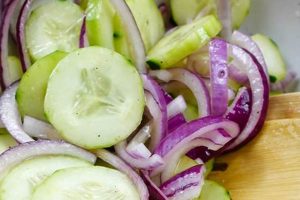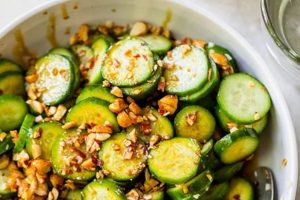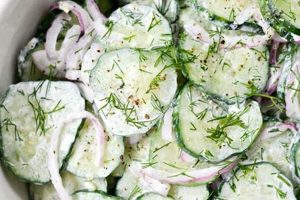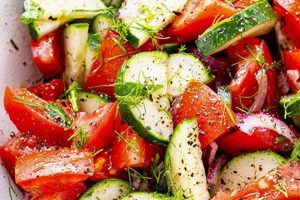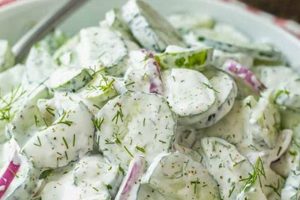A refreshing and hydrating dish, this type of salad combines the sweetness of watermelon with the cool crispness of cucumber. Often enhanced with additional ingredients like feta cheese, mint, red onion, or herbs, and dressed with a light vinaigrette, lime juice, or simply a drizzle of olive oil, variations abound to suit different palates. This simple combination of ingredients creates a vibrant and flavorful summer staple.
Such salads offer numerous nutritional benefits. Watermelon, rich in lycopene and antioxidants, contributes to heart health and provides hydration. Cucumber, a good source of vitamins and minerals, aids in digestion and further boosts hydration. The optional additions of ingredients like feta provide calcium and protein, while fresh herbs offer additional vitamins and antioxidants. Historically, combining fresh, seasonal produce in simple salads has been a culinary tradition across many cultures, reflecting a focus on utilizing readily available ingredients.
This exploration will further delve into specific variations of this salad, offering detailed instructions and highlighting the versatility and adaptability of these core ingredients.
Tips for a Perfect Watermelon Cucumber Salad
Achieving optimal flavor and texture requires attention to detail. The following tips offer guidance for creating a superior culinary experience.
Tip 1: Choose ripe produce. Select a watermelon that feels heavy for its size and has a deep, hollow sound when tapped. Cucumbers should be firm and free from blemishes.
Tip 2: Prepare ingredients properly. Remove watermelon seeds and rind. Consider peeling cucumbers, particularly if the skin is thick or waxed. Consistent sizing of the chopped ingredients ensures even flavor distribution and a pleasant aesthetic.
Tip 3: Balance flavors effectively. The sweetness of watermelon pairs well with salty and acidic elements. Consider adding feta cheese, crumbled goat cheese, or a sprinkle of sea salt. A squeeze of lime or lemon juice, or a light vinaigrette, enhances the flavors.
Tip 4: Enhance with fresh herbs. Mint, dill, and basil complement the flavors of watermelon and cucumber. Finely chop herbs to release their aroma and distribute them evenly throughout the salad.
Tip 5: Add optional ingredients thoughtfully. Red onion adds a pungent bite, while Kalamata olives provide a briny counterpoint. Toasted nuts or seeds offer textural contrast and healthy fats.
Tip 6: Chill before serving. Chilling the salad allows the flavors to meld and enhances the refreshing quality of the dish. However, avoid over-chilling, as this can dull the flavors.
Attention to these details elevates a simple salad into a culinary masterpiece. The combination of fresh, high-quality ingredients and balanced flavor profiles creates a dish that is both nutritious and satisfying.
By following these guidelines, one can create a watermelon cucumber salad that embodies freshness and flavor.
1. Ingredients
Ingredient selection significantly impacts the overall quality and character of a watermelon cucumber salad. The inherent sweetness of watermelon and subtle, refreshing taste of cucumber provide a neutral base upon which diverse flavor profiles can be built. Careful consideration of additional components allows for the creation of salads ranging from sweet and savory to spicy and tangy. For example, incorporating feta cheese and mint yields a Mediterranean-inspired salad, while adding jalapeo and lime juice creates a zesty, Latin-influenced variant. The quality of ingredients also plays a crucial role; ripe, in-season produce maximizes flavor and nutritional value.
Beyond the core ingredients, the selection of complementary items determines the salad’s complexity and nutritional density. Adding protein-rich elements like grilled chicken or chickpeas transforms the salad into a more substantial meal. Incorporating diverse textures, such as toasted nuts or seeds, enhances the sensory experience. Furthermore, the choice of dressing significantly influences the final taste. A light vinaigrette complements the fresh flavors, while a creamy dressing adds richness. Understanding these ingredient interactions allows for precise flavor manipulation and nutritional optimization.
Ultimately, the success of a watermelon cucumber salad hinges on the thoughtful selection and combination of ingredients. Prioritizing fresh, high-quality produce forms the foundation for a flavorful and nutritious dish. A nuanced understanding of flavor pairings and textural interplay allows for customization to suit individual preferences and dietary needs. By recognizing the crucial role of each component, one can elevate this simple salad from a refreshing side dish to a culinary centerpiece.
2. Preparation
Preparation significantly influences the final outcome of a watermelon cucumber salad. Careful execution of specific techniques elevates both the aesthetic appeal and the overall enjoyment of the dish. Consider the impact of cutting techniques; uniformly sized pieces not only enhance presentation but also ensure even distribution of flavor and a consistent textural experience. Furthermore, precise seed removal from the watermelon prevents unwanted bitterness and improves palatability. Proper handling, such as gently tossing ingredients together to avoid bruising, maintains the integrity of the delicate produce. These seemingly minor details contribute significantly to the overall success of the salad.
Beyond the basic steps, preparatory techniques also offer opportunities to enhance the salad’s flavor profile and complexity. Macerating red onions in vinegar before adding them to the salad mellows their pungent bite and infuses them with a subtle sweetness. Similarly, toasting nuts or seeds prior to incorporation adds a depth of flavor and a satisfying crunch. Chilling the prepared salad for a short time allows the flavors to meld and intensifies the refreshing qualities of the ingredients. Such considered preparation demonstrates attention to detail and elevates the dish beyond a simple combination of ingredients.
In conclusion, the preparation phase represents a crucial step in creating a truly exceptional watermelon cucumber salad. Thoughtful execution of techniques, from basic knife skills to nuanced flavor enhancements, demonstrably impacts the final product. An understanding of these processes allows one to fully realize the potential of this refreshing and versatile dish. The transition from basic preparation to advanced techniques highlights the opportunity to transform simple ingredients into a complex and satisfying culinary experience.
3. Flavor Balance
Flavor balance is paramount in a successful watermelon cucumber salad. The inherent sweetness of watermelon requires careful counterpoint to prevent the salad from becoming cloying. Acidity, often introduced through citrus juice like lime or lemon, provides the necessary contrast and brightens the overall flavor profile. Salty elements, such as feta cheese, crumbled goat cheese, or a sprinkle of sea salt, further enhance the complexity and prevent the sweetness from dominating. A proper balance of these contrasting flavors sweet, acidic, and salty creates a harmonious and refreshing culinary experience. For example, a salad with overly ripe watermelon might require more lime juice than a salad using a less sweet melon. The interplay of these flavors elevates the dish beyond a simple combination of ingredients.
Achieving optimal flavor balance requires consideration of the specific ingredients used. The variety of watermelon, for instance, influences its sweetness, requiring adjustments in the proportions of other components. The addition of other elements, such as herbs or spices, introduces further complexity to the flavor profile and necessitates careful balancing. Mint, with its cool, refreshing notes, complements watermelon and cucumber, while a pinch of chili flakes adds a subtle heat that contrasts with the sweetness. Understanding the flavor profiles of individual ingredients and their interactions allows for precise control over the final taste. A recipe incorporating bolder flavors, like a spicy jalapeo vinaigrette, would require careful adjustment of the other components to maintain balance.
Ultimately, mastering flavor balance elevates the watermelon cucumber salad from a simple dish to a culinary expression. The interplay of contrasting tastes creates a dynamic and engaging experience for the palate. Attention to the nuances of flavor, ingredient selection, and proportional balance allows for the creation of a truly exceptional and memorable salad. This understanding allows for adaptation and customization based on individual preferences and available ingredients, ensuring a consistently delightful and refreshing result.
4. Presentation
Presentation significantly influences the perceived appeal and enjoyment of a watermelon cucumber salad. Visual appeal stimulates appetite and enhances the dining experience. A thoughtfully arranged salad elevates the dish beyond simple sustenance, transforming it into a visually engaging culinary creation. Consider the impact of color; the vibrant hues of watermelon and cucumber, contrasted with the bright white of feta or the deep green of fresh herbs, create an enticing visual tableau. Strategic placement of ingredients, such as artfully arranging cucumber ribbons around a central mound of watermelon, adds a touch of elegance. Attention to detail, like garnishing with a sprig of mint or a sprinkle of toasted seeds, further enhances the presentation and demonstrates care in preparation. A simple salad served in a beautiful bowl, with attention to color and texture, becomes significantly more appealing than the same salad haphazardly thrown together.
Beyond aesthetics, presentation also impacts the practical aspects of serving and enjoying the salad. Evenly distributed ingredients ensure that each bite contains a balanced mix of flavors and textures. Appropriate servingware, whether a large platter for a shared salad or individual bowls for portioned servings, contributes to ease of serving and consumption. Consideration of the dining context, from a casual picnic to a formal dinner party, informs presentation choices. A deconstructed salad, with elements arranged separately on a platter, allows guests to customize their portions and encourages interaction. A composed salad, with ingredients carefully arranged in individual servings, lends itself to a more formal setting. The same salad, presented differently, can suit a casual barbeque or an elegant luncheon.
In summary, presentation plays a crucial role in maximizing the enjoyment of a watermelon cucumber salad. Visual appeal stimulates appetite and enhances the dining experience. Thoughtful arrangement, attention to color and texture, and appropriate serving techniques elevate the dish from a simple combination of ingredients to a visually and texturally engaging culinary experience. Understanding the impact of presentation empowers one to transform a simple salad into a memorable and satisfying dish, regardless of the occasion. This attention to detail communicates care and elevates the perceived value of the dish, contributing to a more positive overall dining experience.
5. Nutritional Value
Nutritional value represents a significant aspect of a watermelon cucumber salad recipe. This dish offers a wealth of vitamins, minerals, and antioxidants, contributing to overall health and well-being. Understanding the nutritional composition of this salad provides insights into its potential benefits and allows for informed dietary choices. The inherent nutritional properties of watermelon and cucumber, combined with the potential additions of other nutrient-rich ingredients, make this salad a valuable component of a balanced diet.
- Hydration and Electrolyte Balance
Watermelon and cucumber boast high water content, contributing significantly to daily hydration needs. This is particularly beneficial during warmer months or after physical activity. These ingredients also provide essential electrolytes, crucial for maintaining fluid balance and supporting various bodily functions. The hydrating properties of this salad can contribute to improved energy levels and overall physiological function.
- Vitamin and Mineral Content
This salad offers a range of vitamins and minerals. Watermelon is a good source of vitamin C, an antioxidant that supports immune function, and vitamin A, essential for vision health. Cucumber provides vitamin K, important for blood clotting, and potassium, which helps regulate blood pressure. The combined vitamin and mineral profile of this salad contributes to overall nutritional well-being. Adding ingredients like feta cheese further enhances the mineral content, providing calcium crucial for bone health.
- Antioxidant Properties
Watermelon is rich in lycopene, a powerful antioxidant associated with reduced risk of chronic diseases, including heart disease and certain cancers. Antioxidants protect cells from damage caused by free radicals, contributing to long-term health. The antioxidant benefits of this salad contribute to cellular health and overall disease prevention. The inclusion of other antioxidant-rich ingredients, such as berries or herbs, further amplifies these benefits.
- Low Calorie and High Fiber Content
Watermelon and cucumber are naturally low in calories and high in fiber, making this salad a satisfying and healthy option for those managing weight. Fiber promotes digestive health, aids in satiety, and contributes to stable blood sugar levels. This makes the salad a suitable choice for individuals seeking a light yet nutritious meal or snack. The high fiber content also contributes to digestive regularity and overall gut health.
The combined nutritional benefits of watermelon and cucumber, further enhanced by the potential addition of other nutrient-rich ingredients, make this salad a valuable contribution to a balanced diet. From hydration and electrolyte balance to vitamin and mineral intake, antioxidant protection, and weight management support, this seemingly simple salad offers a range of health benefits. Understanding these nutritional contributions allows for informed choices and highlights the potential of food as a source of both enjoyment and well-being.
6. Variations
The inherent simplicity of a watermelon cucumber salad provides a versatile foundation for numerous variations. Adaptability to diverse flavor profiles and dietary needs makes this salad a canvas for culinary creativity. Exploring these variations expands culinary horizons and allows for customization based on personal preferences, seasonal availability, and desired nutritional outcomes. Each variation, while retaining the core essence of the dish, offers a unique sensory experience.
- Savory Additions
Incorporating savory elements transforms the salad from a light refreshment into a more substantial dish. Feta cheese, crumbled goat cheese, or halloumi provide salty, tangy notes and a creamy texture. Adding olives, such as Kalamata or Castelvetrano, introduces a briny, savory dimension. Proteins like grilled chicken, shrimp, or chickpeas further enhance the nutritional value and create a complete meal. These additions cater to diverse palates and dietary preferences, expanding the salad’s versatility. For example, grilled halloumi offers a salty, firm counterpoint to the sweetness of watermelon, while the addition of chickpeas provides plant-based protein and fiber.
- Herbal Infusions
Fresh herbs contribute distinct aromatic notes and enhance the refreshing quality of the salad. Mint provides a cooling, slightly sweet flavor that complements both watermelon and cucumber. Dill adds a subtle anise-like flavor, while basil offers a peppery, slightly minty note. Other herbs, such as cilantro or parsley, can also be incorporated to create unique flavor profiles. The choice of herbs allows for customization based on personal preferences and complements other added ingredients. For instance, mint pairs well with feta and a lemon vinaigrette, while dill complements the addition of smoked salmon or other seafood.
- Spicy Influences
Introducing spicy elements adds a dynamic dimension to the salad. A pinch of chili flakes or a diced jalapeo pepper provides a fiery kick that contrasts with the sweetness of the watermelon. Incorporating a spicy dressing, such as a sriracha-lime vinaigrette, infuses the entire salad with heat. The level of spice can be adjusted to suit individual preferences, ranging from a subtle warmth to a fiery intensity. A salad with jalapeo and cilantro offers a vibrant, Southwestern-inspired flavor profile.
- Textural Contrasts
Adding ingredients with contrasting textures enhances the sensory experience of the salad. Toasted nuts, such as almonds or pecans, provide a satisfying crunch. Seeds, like pumpkin or sunflower seeds, offer a nutty flavor and a delicate crispness. Crumbled bacon or crispy prosciutto adds a salty, savory crunch. These textural elements create a more dynamic and engaging culinary experience. A salad with toasted pepitas and crumbled feta offers a delightful interplay of creamy, crunchy, and salty textures.
These variations highlight the adaptability of the watermelon cucumber salad, demonstrating its potential to accommodate diverse tastes and dietary needs. By thoughtfully combining ingredients and considering flavor profiles, textures, and nutritional goals, one can create a customized salad that is both refreshing and satisfying. The variations presented serve as a starting point for further exploration and culinary creativity, showcasing the versatility of this simple yet dynamic dish.
Frequently Asked Questions
This section addresses common inquiries regarding watermelon cucumber salads, providing concise and informative responses to facilitate a deeper understanding of this versatile dish.
Question 1: How long can this salad be stored?
Refrigeration in an airtight container is recommended for up to 3 days. However, optimal flavor and texture are experienced within 24 hours of preparation. Freezing is not recommended, as it compromises the texture of both watermelon and cucumber.
Question 2: Can other melons be substituted for watermelon?
While watermelon provides a distinct sweetness and texture, other melons like cantaloupe or honeydew can be substituted. Adjustments to other ingredients, such as acidity and herbs, may be necessary to achieve optimal flavor balance.
Question 3: What dressings work best with this salad?
Light vinaigrettes, often based on lime or lemon juice, complement the fresh flavors. A simple olive oil and balsamic glaze also provides a pleasant contrast. Creamy dressings are generally less suitable, as they can overpower the delicate flavors of the salad.
Question 4: How can one prevent the salad from becoming watery?
Salting the chopped cucumber and allowing it to sit for a short period draws out excess moisture. Thoroughly patting the cucumber dry before combining it with other ingredients also helps maintain the salad’s crispness. Adding the dressing just before serving further minimizes wateriness.
Question 5: Is this salad suitable for specific dietary restrictions?
The basic recipe is naturally gluten-free, vegan, and paleo-friendly. Adaptations for other dietary needs are easily accommodated. For instance, substituting agave nectar for honey makes the salad suitable for vegans. Ensuring all added ingredients align with specific dietary guidelines is essential.
Question 6: Can this salad be served as a main course or only as a side dish?
While typically served as a refreshing side dish, the addition of protein-rich ingredients like grilled chicken, fish, or legumes transforms the salad into a satisfying main course. Nutritional value and portion size can be adjusted to suit individual dietary requirements and preferences.
Understanding these common inquiries provides clarity and empowers culinary exploration of the versatile and refreshing watermelon cucumber salad. Attention to ingredient selection, preparation techniques, and flavor balance further ensures a consistently satisfying culinary experience.
Additional recipe ideas and serving suggestions can be found in the following section.
Recipe Watermelon Cucumber Salad
Exploration of recipe watermelon cucumber salad reveals a dish characterized by simplicity, versatility, and nutritional value. Key aspects, including ingredient selection, preparation techniques, flavor balance, and presentation, contribute significantly to the final culinary outcome. Careful consideration of these elements allows for customization and adaptation to diverse palates and dietary preferences. The inherent refreshing qualities of watermelon and cucumber, combined with the potential for incorporating various complementary ingredients, position this salad as a versatile culinary staple.
Recipe watermelon cucumber salad represents more than a mere combination of ingredients; it embodies a culinary philosophy centered on fresh, seasonal produce and balanced flavors. Further exploration of variations and flavor combinations promises continued culinary discovery. The adaptability of this salad ensures its enduring appeal and its potential to remain a refreshing and nutritious component of diverse culinary traditions.


